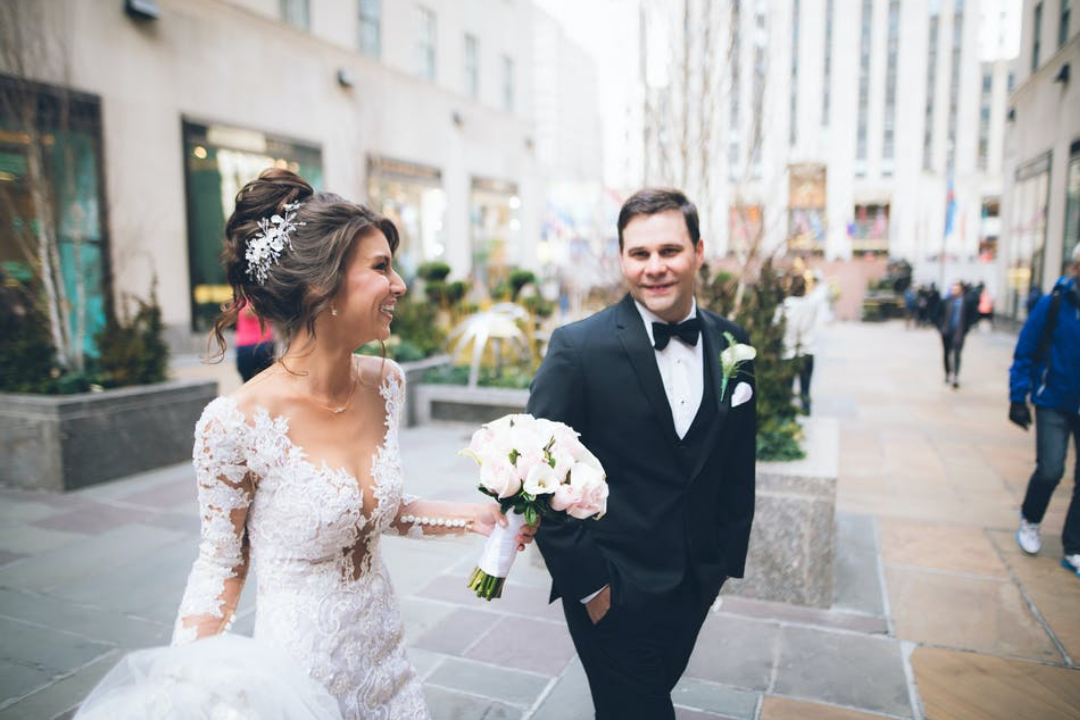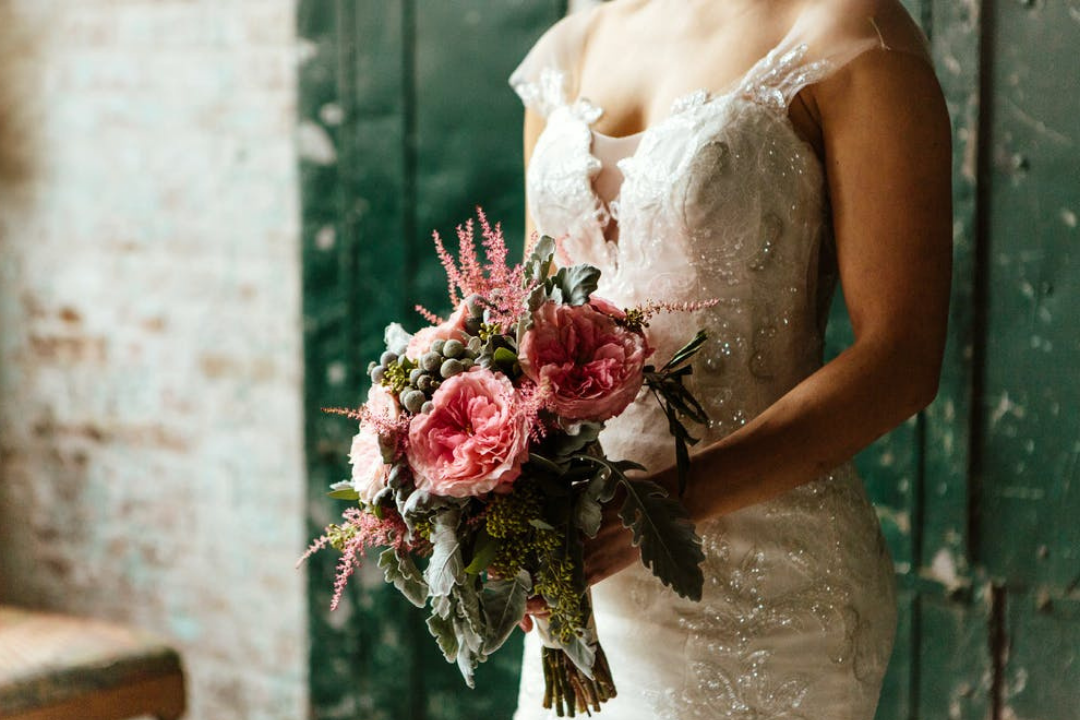- Expert advice/
- Fashion & beauty/
- Wedding dresses/
- Average Wedding Dress Alteration Costs: Breakdown & Budgeting Tips
- Wedding dresses
Average Wedding Dress Alteration Costs: Breakdown & Budgeting Tips
How much do wedding dress alterations cost? Standard adjustments run $300 to $800, with simple fixes starting from $50 and complex custom work over $1,000.
Last updated September 30, 2025

- Budget $300-$800 for alterations: Most brides need multiple adjustments like hemming, taking in the bodice, and adding a bustle, with costs varying based on dress complexity and local market rates
- Book 8-10 weeks before your wedding: Starting alterations early prevents rush fees (which can increase costs by 25-50%) and allows time for multiple fittings to ensure perfect fit
- Factor alterations into your dress budget from the start: Add 20-30% of your dress cost to cover typical modifications, and research local seamstresses early to understand pricing in your area
- Simple changes cost less than complex ones: Basic hemming and fit adjustments are more affordable than major structural changes, beadwork repairs, or adding sleeves, which can reach $1,200+
You've found your dream wedding dress, but the next step is ensuring a perfect fit through alterations. Understanding alteration costs is key to staying on budget, and this guide breaks down everything you need to know to plan confidently.
Most brides need some adjustments to their wedding dress, whether it's hemming the length or taking in the bodice for a better fit. Understanding what alterations cost and how the process works helps you budget properly and avoid surprises during your planning.
How Much Do Wedding Dress Alterations Cost?
Wedding dress alterations are adjustments made to ensure your gown fits perfectly and feels comfortable throughout your wedding day. These modifications range from simple hem adjustments to complex structural changes that can transform how your dress looks and feels.
Most wedding gown alterations cost between $300 and $800 for standard modifications. Complex structural changes or extensive detail work can push costs higher, sometimes reaching $1,200 or more. Your final bill depends on which specific services you need, your dress's construction, and your seamstress's expertise level.
Here's what most brides can expect to budget:
- Basic alterations: $300-$600 for hemming, simple bustles, and minor fit adjustments
- Complex alterations: $700-$1,200+ for major structural changes and extensive beadwork
Understanding these price ranges helps you plan your wedding dress budget more accurately. It also helps you decide which alterations are essential versus nice-to-have upgrades.

What Do Common Alterations Cost?
Even perfectly sized wedding dresses usually need some adjustments. Your body proportions, posture, and preferred fit all influence what modifications your dress will need.
Hemming
Hemming adjusts your dress length to work with your height and chosen shoes. Basic hemming on simple gowns starts around $150. Multi-layer dresses with lace or beading can cost $300 to $500 for professional hemming.
The hemming technique affects your final cost significantly. Hand-rolled hems take more time but create beautiful finishes on delicate fabrics. Machine hemming works well for simpler designs but may not suit intricate lace patterns or heavy beading along the bottom edge.
Your heel height choice impacts hemming complexity too. Bringing your wedding shoe to the fitting helps your seamstress create the perfect length.
Taking in or letting out
Taking in narrows your dress through the bodice, waist, or hip areas for a better fit. This alteration typically costs $100 to $400 based on how many areas need adjustment and your dress's construction complexity.
Taking fabric in is generally easier than letting it out. Most dresses have limited seam allowances, restricting how much they can be enlarged. Your seamstress can usually let out dresses by one to two inches maximum without compromising the design integrity.
Side seam adjustments work best for minor size changes. Larger adjustments may require taking in multiple seam areas, which increases both time and cost for the modification work.
Adding a Bustle
Bustles lift and secure your train so you can move freely during your reception. Simple bustles cost $75 to $200, while elaborate multi-point bustles for longer trains can reach $300 to $400.
Different bustle styles create different looks and functionality:
- American bustle: Lifts fabric up and over for maximum floor clearance
- French bustle: Creates elegant folds underneath the dress
- Austrian bustle: Uses ribbons to create gathered, romantic draping
Your train length and dress style determine which bustle type works best. Longer trains need more pickup points which can increase the complexity and cost of installation.
Strap Adjustments
Strap modifications include shortening existing straps, adding new ones, or changing strap styles entirely. Simple shortening costs $30 to $75. Adding straps to strapless designs ranges from $100 to $250.
Converting between strap styles requires careful planning. Your seamstress must consider your dress's neckline, back design, and overall structure. Adding straps to a strapless gown means ensuring proper support without compromising the dress's original design aesthetic.
Strap placement affects both comfort and appearance. Your seamstress will consider your shoulder shape, bra requirements, and how the straps integrate with existing dress details like beading or lace patterns.
Adding Cups
Built-in cups provide support and create smooth lines under fitted bodices. This modification costs $30 to $60 and makes a significant difference in comfort throughout your wedding day.
Professional cup installation ensures proper placement and secure attachment. Cups must be positioned to provide support without creating visible lines or bulges under your dress fabric.
This alteration is especially important for strapless or low-back designs where traditional bras won't work. Built-in support eliminates the need to find special undergarments that work with your dress style.
What Do Complex Alterations Cost?
Complex wedding dress alterations involve significant structural changes or intricate detail work. These modifications require advanced sewing skills and considerably more time than basic adjustments.
Major structural changes include reshaping necklines, adding or removing sleeves, and modifying the dress's fundamental silhouette. Neckline changes cost $200 to $500 depending on the complexity involved. Adding sleeves to a sleeveless dress ranges from $300 to $600.
Extensive beadwork or lace repair commands premium pricing. Preserving intricate embellishments while making fit adjustments requires master-level expertise. These detailed alterations can cost $400 to $800 or more.
Corset additions strengthen dress structure while providing better fit and support. Adding internal boning and lacing systems costs $250 to $500. This modification works well for strapless designs or when significant size adjustments are needed.
Custom design changes that alter your dress's basic silhouette represent the most complex alterations. Converting an A-line to a fitted mermaid cut wedding dress or changing a ballgown to a sheath dress can cost $500 to $1,000 or more.
These situations often require complex alterations:
- Family heirloom updates: Modernizing grandmother's dress while preserving sentimental details
- Dramatic size changes: When weight fluctuations exceed two dress sizes
- Style evolution: Changing your vision after purchasing the dress
- Fit challenges: Accommodating unique body proportions or physical limitations
Complex alterations require experienced bridal seamstresses who understand dress construction principles. The investment reflects both the time involved and the specialized expertise needed to execute major changes successfully.

What Affects Alteration Prices?
Multiple factors beyond the specific services needed influence your final alteration costs. Understanding these variables helps you budget appropriately and avoid unexpected expenses.
Fabric type and quality significantly impact pricing. Silk requires different handling than polyester blends. Delicate fabrics like chiffon or organza demand extra care and skill. Heavy fabrics like mikado or duchess satin need different techniques than lightweight materials.
Embellishment density and type affect both complexity and time requirements. Hand-sewn beading takes longer to work around than machine-applied sequins. Lace appliques require careful removal and reattachment. Three-dimensional flowers or pearls need individual attention during alterations. Keeping these in mind from the beginning when dress shopping can help keep a realistic budget for the dress and alterations.
Construction details influence alteration difficulty. Dresses with built-in corsetry have different requirements than simple lined gowns. Multiple fabric layers increase complexity. Princess seaming creates different challenges than empire waistlines.
Geographic location creates substantial price variations across different markets. Wedding dress alterations in Manhattan will typically cost more than Salt Lake City. These location differences reflect varying costs of living and market demand.
Seasonal timing impacts both availability and pricing. Peak wedding season from April through October creates higher demand for alteration appointments. Many seamstresses charge premium rates during busy months.
Seamstress specialization level varies significantly between different providers. Bridal specialists command higher rates than general tailors, so be sure to research and shop around to find the expertise you need. Master seamstresses with decades of experience charge more than newer practitioners. Specialized training in couture techniques or specific designer brands affects pricing.
Shop overhead and reputation influence base pricing structures. High-end bridal salons typically charge more than independent seamstresses working from home studios. Shop location, rent costs, and clientele expectations all factor into pricing models.
When Should You Book Alterations?
Knowing how long wedding dress alterations take prevents rushed work and eliminates expensive emergency fees. Starting too late limits your options and increases stress during an already busy time.
Book your first alteration appointment 8 to 10 weeks before your wedding date. This timeline provides adequate time for multiple fittings while avoiding rush charges that can increase costs by 25 to 50 percent.
Your fitting schedule should follow this pattern:
- Initial consultation: 8-10 weeks out for measurements and planning
- First fitting: 6-8 weeks out for major adjustments and pinning
- Second fitting: 4-6 weeks out for refinements and bustle installation
- Final fitting: 2-3 weeks out for last checks and minor tweaks
Each appointment serves specific purposes in the alteration process. Your initial consultation involves taking detailed measurements, discussing your vision, and creating a work plan. The seamstress explains what modifications are needed and provides cost estimates.
Your first fitting focuses on major structural adjustments. The seamstress pins changes and may complete some work between this appointment and your next visit. You'll try on the dress with your actual undergarments and wedding shoes.
Second fittings allow you to see progress and request refinements. Your bustle gets installed and tested during this appointment. Any remaining adjustments get planned and scheduled.
Final fittings ensure everything fits perfectly and functions properly. This appointment catches any last-minute issues and allows final minor adjustments if needed.
Backup planning protects against unexpected delays. Leave buffer time in your schedule for potential additional fittings. Consider what happens if alterations take longer than expected or if last-minute changes become necessary.
How to Save on Alterations
Smart planning reduces alteration costs without compromising quality or fit. These strategies focus on making informed decisions throughout the dress selection and alteration process.
Buy the right size from the beginning to minimize necessary alterations. Purchase dresses closest to your largest measurement rather than your smallest. Taking in fabric costs less than letting out or adding fabric panels.
Understand your body shape and common fit issues before shopping. If you always need sleeves shortened, factor that into your budget. If you typically need waist adjustments, choose designs that accommodate easy modifications.
Choose alteration-friendly designs when possible. A-line silhouettes require fewer adjustments than fitted mermaid styles. Simple constructions cost less to modify than complex multilayer designs. Minimal beading reduces alteration complexity and time requirements.
Research seamstresses early in your planning process to understand local pricing and availability. Get recommendations from other brides and bridal shops. Read reviews and view before-and-after photos of their work.
Ask detailed questions during consultations to avoid surprise costs:
- What's included in quoted prices: Understand whether fittings are charged separately
- Additional fee possibilities: Learn about rush charges, weekend appointments, or special technique costs
- Payment schedules: Know when deposits are due and final payments are expected
- Alteration guarantees: Understand policies if additional work becomes necessary
Consider timing flexibility to access standard pricing rather than rush fees. Book appointments well in advance. Avoid peak season if possible.
Maintain realistic expectations about what alterations can and cannot achieve. Some fit issues may require complex modifications that cost more than the original dress.
Plan Your Alterations Budget
Wedding dress alterations deserve dedicated budget planning as part of your overall wedding expenses. Many brides underestimate these costs and face unpleasant surprises during the planning process.
Factor alteration expenses into your dress budget from the very beginning rather than treating them as afterthoughts. A good rule of thumb is adding 20 to 30 percent of your dress cost to cover typical modification needs.
Budget planning steps include:
- Research local market rates to understand typical pricing in your area
- Get multiple consultations to compare costs and approaches from different seamstresses
- Create line items for each anticipated alteration rather than using one lump sum
- Include contingency funds for unexpected modifications or additional fittings
Track all wedding expenses to maintain perspective on your overall spending priorities. Our free budget tool helps you track spending to see how alteration costs fit into your overall wedding finances.
Consider payment timing when planning your budget. Most seamstresses require deposits when booking appointments and final payments at completion. Factor these timing requirements into your overall wedding payment schedule.
Document all alteration agreements in writing to avoid misunderstandings about costs and services. Keep receipts and contracts for reference. Understand cancellation policies and change fees before committing to services.
Frequently Asked Questions
Why are bridal alterations more expensive than regular clothing alterations?
Wedding dresses require specialized construction knowledge and techniques that differ significantly from everyday clothing. Bridal seamstresses work with delicate fabrics, complex embellishments, and intricate construction details that demand advanced skills and extra time to modify properly.
Which wedding dress alterations are absolutely necessary?
Hemming is essential for most brides to achieve proper length with their chosen shoes. Basic fit adjustments through the bodice ensure comfort and proper silhouette. Bustles are highly recommended for any dress with a train to enable comfortable movement during your reception.
How can I tell if an alteration quote is reasonable or overpriced?
Compare quotes from at least three experienced bridal seamstresses in your area. Ask for detailed written estimates that break down costs by specific alteration type. Be cautious of quotes that seem extremely high or unusually low, as both can indicate potential quality or service issues.
- Expert advice/
- Fashion & beauty/
- Wedding dresses/
- Average Wedding Dress Alteration Costs: Breakdown & Budgeting Tips
Find even more wedding ideas, inspo, tips, and tricks
We’ve got wedding planning advice on everything from save the dates to wedding cakes.
